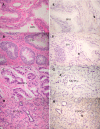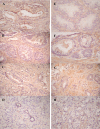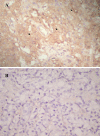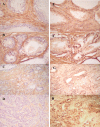Expression of biomarkers modulating prostate cancer angiogenesis: differential expression of annexin II in prostate carcinomas from India and USA
- PMID: 14613585
- PMCID: PMC270077
- DOI: 10.1186/1476-4598-2-34
Expression of biomarkers modulating prostate cancer angiogenesis: differential expression of annexin II in prostate carcinomas from India and USA
Abstract
Background: Prostate cancer (PCa) incidences vary with genetic, geographical and ethnic dietary background of patients while angiogenesis is modulated through exquisite interplay of tumor-stromal interactions of biological macromolecules. We hypothesized that comprehensive analysis of four biomarkers modulating angiogenesis in PCa progression in two diverse populations might explain the variance in the incidence rates.
Results: Immunohistochemical analysis of 42 PCa biopsies reveals that though Anx-II expression is lost in both the Indian and American population with Gleason scores (GS) ranging between 6 and 10, up to 25 % of cells in the entire high grade (GS > 8) PD PCa samples from US show intense focal membrane staining for Anx-II unlike similarly graded specimens from India. Consistent with this observation, the prostate cancer cell lines PC-3, DU-145 and MDA PCa 2A, but not LNCaP-R, LNCAP-UR or MDA PCa 2B cell lines, express Anx-II. Transcriptional reactivation of Anx-II gene with Aza-dC could not entirely account for loss of Anx-II protein in primary PCa. Cyclooxygenase-2 (COX-2) was moderately expressed in most of high grade PIN and some MD PCa and surrounding stroma. COX-2 was not expressed in PD PCa (GS approximately 7-10), while adjacent smooth muscles cells stained weakly positive. Decorin expression was observed only in high grade PIN but not in any of the prostate cancers, atrophy or BPH while stromal areas of BPH stained intensively for DCN and decreased with advancing stages of PCa. Versican expression was weak in most of the MD PCa, moderate in all of BPH, moderately focal in PD PC, weak and focal in PIN, atrophy and adjacent stroma.
Conclusions: Expression of pro- and anti-angiogenic modulators changes with stage of PCa but correlates with angiogenic status. Focal membrane staining of Anx-II reappears in high grade PCa specimens only from US indicating differential expression of Anx-II. COX-2 stained stronger in American specimens compared to Indian specimens. The sequential expression of DCN and VCN in progressive stages was similar in specimens from India and USA indicating no population-based differences. The mechanistic and regulatory role of Anx-II in PCa progression warrants further investigation.
Figures






Similar articles
-
Cyclooxygenase-2 is up-regulated in proliferative inflammatory atrophy of the prostate, but not in prostate carcinoma.Cancer Res. 2001 Dec 15;61(24):8617-23. Cancer Res. 2001. PMID: 11751373
-
Prostate stem cell antigen (PSCA) expression in human prostate cancer tissues: implications for prostate carcinogenesis and progression of prostate cancer.Jpn J Clin Oncol. 2004 Jul;34(7):414-9. doi: 10.1093/jjco/hyh073. Jpn J Clin Oncol. 2004. PMID: 15342669
-
Differential expression of cyclooxygenase-2 and its regulation by tumor necrosis factor-alpha in normal and malignant prostate cells.Cancer Res. 2001 Mar 15;61(6):2720-6. Cancer Res. 2001. PMID: 11289153
-
Review: molecular pathology of cyclooxygenase-2 in cancer-induced angiogenesis.Ann Clin Lab Sci. 2001 Oct;31(4):325-48. Ann Clin Lab Sci. 2001. PMID: 11688844 Review.
-
Annexin A2 (ANX A2): An emerging biomarker and potential therapeutic target for aggressive cancers.Int J Cancer. 2019 May 1;144(9):2074-2081. doi: 10.1002/ijc.31817. Epub 2018 Oct 31. Int J Cancer. 2019. PMID: 30125343 Review.
Cited by
-
Decorin suppresses prostate tumor growth through inhibition of epidermal growth factor and androgen receptor pathways.Neoplasia. 2009 Oct;11(10):1042-53. doi: 10.1593/neo.09760. Neoplasia. 2009. PMID: 19794963 Free PMC article.
-
A local paracrine and endocrine network involving TGFβ, Cox-2, ROS, and estrogen receptor β influences reactive stromal cell regulation of prostate cancer cell motility.Mol Endocrinol. 2012 Jun;26(6):940-54. doi: 10.1210/me.2011-1371. Epub 2012 May 16. Mol Endocrinol. 2012. PMID: 22593181 Free PMC article.
-
GAS6/AXL axis regulates prostate cancer invasion, proliferation, and survival in the bone marrow niche.Neoplasia. 2010 Feb;12(2):116-27. doi: 10.1593/neo.91384. Neoplasia. 2010. PMID: 20126470 Free PMC article.
-
ERG oncoprotein inhibits ANXA2 expression and function in prostate cancer.Mol Cancer Res. 2015 Feb;13(2):368-79. doi: 10.1158/1541-7786.MCR-14-0275-T. Epub 2014 Oct 24. Mol Cancer Res. 2015. PMID: 25344575 Free PMC article.
-
Quantitative immunohistochemical detection of the molecular expression patterns in proliferative inflammatory atrophy.J Mol Histol. 2007 Mar;38(1):1-11. doi: 10.1007/s10735-006-9070-5. Epub 2006 Dec 15. J Mol Histol. 2007. PMID: 17171435 Clinical Trial.
References
-
- Srinivas V, Mehta H, Amin A, Choudary R, Gadgil N, Ravishanker D, Phadke AG. Carcinoma of the prostate--state at initial presentation. Int Urol Nephrol. 1995;27:419–422. - PubMed
Publication types
MeSH terms
Substances
LinkOut - more resources
Full Text Sources
Medical
Research Materials
Miscellaneous

